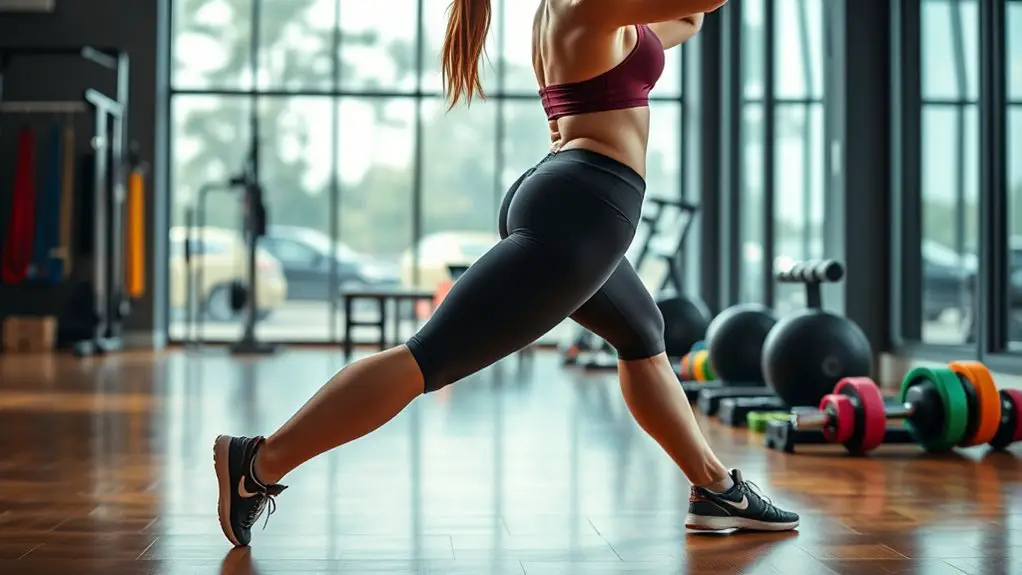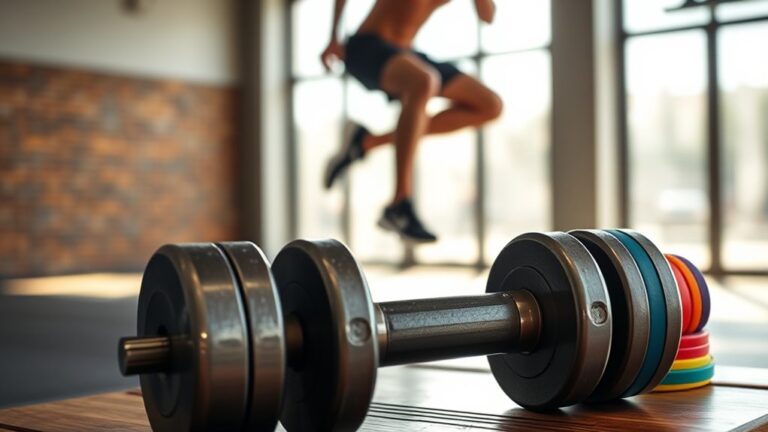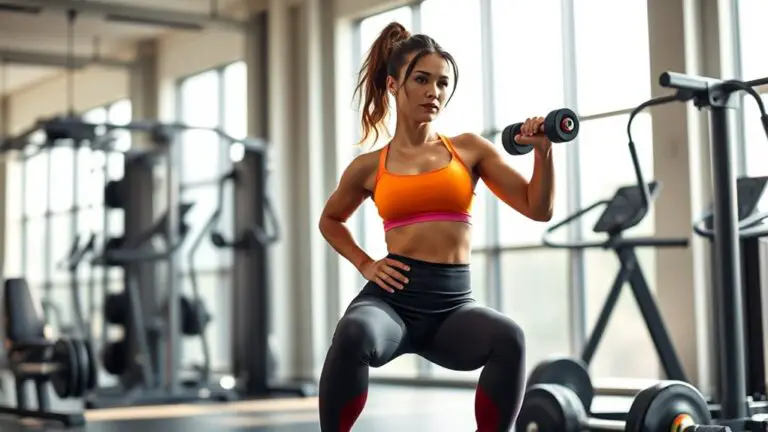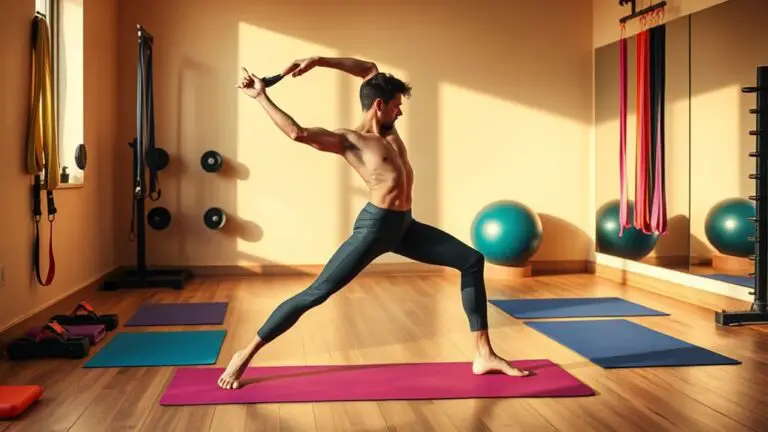The Best Gym Workouts for Glute Growth

To maximize your glute growth, focus on foundational exercises like squats and deadlifts. Incorporate lunges and hip thrusts to target different muscle fibers and enhance activation. Don’t forget to warm up with glute activation exercises, such as bridges, to prepare your muscles. Mixing in accessory exercises and prioritizing proper form will guarantee continued progress. Keep your workouts varied and intense, and you’ll see great results. There’s plenty more to explore on this topic to boost your gains.
Understanding Glute Anatomy and Function

The glutes, often considered the powerhouse of your lower body, play an essential role in movement and stability. Understanding glute functions is fundamental for enhancing your workouts safely. These muscles consist of three primary muscle fibers: the gluteus maximus, gluteus medius, and gluteus minimus, each serving different purposes. The gluteus maximus is responsible for hip extension and external rotation, which helps in activities like running and climbing. The gluteus medius aids in hip stabilization and is crucial for maintaining balance during movements. Finally, the gluteus minimus supports hip abduction and internal rotation, contributing to your overall mobility. By focusing on these functions, you can tailor your workouts to target these muscles effectively. Prioritizing proper form and technique will not only maximize your results but also reduce the risk of injury, ensuring that your journey toward glute growth remains safe and effective.
Warm-Up Exercises for Glute Activation
Before you jump into your workout, warming up your glutes is essential for maximizing growth. Dynamic stretching techniques and resistance band drills can help activate those muscles and prepare them for action. Let’s explore these effective warm-up exercises to get you started on the right foot.
Dynamic Stretching Techniques
While dynamic stretching might seem like just another part of your warm-up routine, it’s essential for activating your glutes effectively. These dynamic warm ups not only enhance flexibility but also prepare your muscles for the workout ahead, promoting safety and performance. Incorporate the following dynamic stretching techniques to get your glutes firing:
| Exercise | Duration | Benefits |
|---|---|---|
| Leg Swings | 30 seconds | Increases hip flexibility |
| Walking Lunges | 30 seconds | Activates glute muscles |
| High Knees | 30 seconds | Improves mobility |
| Glute Bridges | 30 seconds | Engages glute activation |
| Lateral Leg Raises | 30 seconds | Targets hip abductors |
Resistance Band Drills
Resistance band drills can be a game-changer for glute activation. These exercises help guarantee your glutes are fully engaged before you plunge into heavier lifts, reducing the risk of injury. Start with a resistance band placed just above your knees to enhance band resistance. Try lateral band walks to activate your glutes as you step side to side, keeping your core tight. Glute bridges with the band can also boost activation; press your knees outward as you lift your hips to engage those muscles fully. Remember to maintain control throughout each movement and focus on proper form. Incorporating these drills into your warm-up routine can greatly improve your glute strength and overall workout performance.
Squats: The Foundation of Glute Training

When you think about building strong glutes, squats are often the go-to exercise that comes to mind. They’re foundational for glute training and can be modified through various squat variations, guaranteeing you find the right fit for your fitness level. Whether you’re doing bodyweight squats or adding weights, it’s vital to focus on proper form to prevent injury.
Pay attention to squat depth; aim to lower yourself until your thighs are parallel to the ground, or deeper if your mobility allows. This guarantees maximum activation of your glute muscles. If you’re new to squats, start with a basic variation and gradually increase the difficulty as you become more comfortable. Remember, quality over quantity is key—performing fewer, well-executed squats can be more effective than rushing through multiple reps. Prioritize safety and listen to your body for the best results in your glute growth journey.
Deadlifts: Building Strength and Size
After mastering squats, adding deadlifts to your routine can considerably enhance your glute training. Deadlifts are fantastic for building strength and size in your glutes, but it’s vital to prioritize safety. Start with basic deadlift variations, like the conventional and sumo deadlifts, to find what works best for you.
When performing deadlifts, focus on your form. Keep your feet shoulder-width apart, and grip the barbell just outside your knees. As you lift, engage your core and maintain a straight back—this’ll help prevent injury. Remember to push through your heels and squeeze your glutes at the top of the lift.
Incorporating deadlifts into your workout routine not only boosts your glute strength but also enhances overall stability. Don’t rush; take your time to master each variation and pay attention to your body’s signals to guarantee safe and effective training.
Lunges: Targeting Different Glute Muscles

Lunges are a fantastic way to target different glute muscles, and they can really enhance your workout routine. Forward lunges help activate the gluteus maximus, while reverse lunges offer unique benefits and variations to switch things up. Let’s explore how each type can contribute to your glute growth.
Forward Lunges Benefits
Forward lunges are an excellent exercise for sculpting and strengthening your glutes. By stepping forward, you create a dynamic range of motion that targets different glute muscles effectively. One of the key forward lunges benefits is the enhanced muscle engagement it offers. As you lower your body, your glutes, quads, and hamstrings work in harmony, promoting overall stability and strength.
To guarantee safety while performing forward lunges, keep your core engaged and maintain proper form to avoid strain. Make sure your front knee stays aligned over your ankle, preventing unnecessary pressure on your joints. Incorporating forward lunges into your workout routine can lead to improved glute development and better athletic performance, making them a must-try for any fitness enthusiast.
Reverse Lunges Variations
While forward lunges effectively activate your glutes, reverse lunges offer a unique way to target different muscle fibers in the gluteal region. By using proper reverse lunges technique, you can minimize strain on your knees while maximizing reverse lunges benefits, including improved balance and strength.
| Variation | Targeted Area |
|---|---|
| Standard Reverse Lunge | Gluteus Maximus |
| Curtsy Reverse Lunge | Gluteus Medius |
| Elevated Reverse Lunge | Hamstrings & Glutes |
Incorporate these variations into your routine, focusing on form and control. Start with body weight, then gradually add resistance as your confidence grows. Remember, prioritizing safety and maintaining good posture is key for effective glute growth.
Hip Thrusts: Isolating the Glutes
Hip thrusts are one of the most effective exercises for isolating and targeting your glutes. This movement focuses directly on glute activation, making it a staple in any glute growth routine. To perform a hip thrust safely, sit on the ground with your upper back against a bench, feet flat on the floor. As you lift your hips, make sure your core is engaged and your knees are aligned with your toes.
You can also explore hip thrust variations, such as single-leg thrusts or banded thrusts, to increase intensity and further isolate those glutes. These variations not only enhance glute activation but also help prevent plateaus in your strength training. Remember to start with lighter weights to master your form, and gradually increase the resistance as you feel comfortable. Always listen to your body and prioritize safety to maximize your glute growth effectively.
Accessory Exercises for Enhanced Growth
To maximize your glute growth, incorporating accessory exercises into your routine can be highly beneficial. These exercises, like glute bridges and cable kickbacks, help guarantee proper glute activation, targeting those muscles more effectively. By adding them to your regimen, you’re not just enhancing strength but also improving muscle recovery post-workout.
Consider including resistance bands for lateral walks, which activate your glutes while promoting stability. This addition can prevent injury, allowing for safer lifts during primary exercises. It’s also essential to pay attention to your form; maintaining proper technique will protect your joints and guarantee you’re getting the most from each movement. Additionally, incorporating Romanian deadlifts into your routine can further enhance your glute strength while ensuring safety for your lower back.
Tips for Maximizing Your Glute Workout
When you’re aiming to maximize your glute workout, focusing on both intensity and variety can make a significant difference. Start by incorporating compound lifts like squats and deadlifts, but don’t forget to mix in isolation exercises like hip thrusts and glute bridges. Vary your rep ranges to keep your muscles challenged while ensuring you maintain proper form to avoid injury.
Don’t overlook the importance of glute recovery; it’s just as vital as the workout itself. Allow adequate rest between sessions and consider active recovery days with light activity.
Nutrition strategies are key too. Fuel your body with a balanced diet rich in protein, healthy fats, and complex carbs to support muscle growth and recovery. Staying hydrated is essential, as it aids in performance and recovery. By combining these elements, you’ll optimize your glute workouts effectively and safely.
Frequently Asked Questions
How Often Should I Train My Glutes Each Week?
When it comes to training your glutes, you should aim for about 2 to 3 times a week. This frequency allows for ideal glute recovery, ensuring you’re not overworking your muscles. It’s important to listen to your body; if you feel fatigued or sore, don’t hesitate to take an extra rest day. Balancing workout frequency with proper recovery helps prevent injury and promotes effective growth, so you’ll see results safely and efficiently.
Can I Grow My Glutes Without Using Weights?
Absolutely, you can achieve glute growth without weights! By mastering bodyweight exercises like squats, lunges, and glute bridges, you’re setting a solid foundation. Adding resistance bands can amplify your efforts, creating the perfect partnership for progress. Just remember to prioritize proper form to guarantee safety while you sculpt those glutes. With consistency and creativity, you’ll see results without stepping into the weight room. Keep it fun and focused—your glutes will thank you!
What Nutrition Supports Glute Growth Effectively?
To support glute growth effectively, focus on incorporating high-quality protein sources into your diet. Lean meats, fish, legumes, and dairy are great options. Meal timing is essential too; try to consume protein-rich meals or snacks within a couple of hours post-workout to optimize recovery. Don’t forget to balance your diet with healthy fats and carbs for overall energy and muscle repair. Staying hydrated will also aid your progress safely.
Are There Any Common Mistakes to Avoid When Training Glutes?
So, you think you can just waltz into the gym, throw around weights, and magically sculpt your glutes? Not quite! Avoid common mistakes like neglecting glute activation or ignoring proper workout form. Your glutes won’t magically grow just because you’re lifting heavy; they need attention. Focus on engaging those muscles and maintaining good form to prevent injury. It’s not just about looking good; it’s about keeping it safe while you strut your stuff!
How Long Will It Take to See Results in My Glutes?
You might start seeing results in your glutes within four to six weeks, but it really depends on your consistency and effort. Incorporating glute activation exercises is essential for effective training. Don’t forget the importance of muscle recovery; giving your glutes time to heal will help prevent injury and promote growth. Stay patient and focus on your form, and you’ll notice improvements in strength and shape over time.





